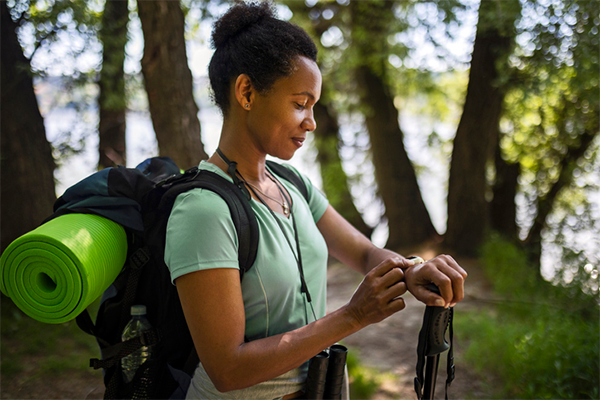Finding the motivation to commute to a gym — not to mention working out when you get there — is a struggle. It’s time to take advantage of that little thing we do each time we run errands, park our cars, or take the stairs: walking.
But can you actually lose weight with walking as your main form of exercise?
I spent 30 days hoofing it, and I’m happy to report that you can!
Here are my results:
- Weight on Day 1: 227 pounds
- Weight on Day 30: 222 pounds
A lot happened in those 30 days, so let’s start at the beginning.
Walking to Lose Weight: The Ground Rules
To make the walking for weight loss experiment a success, I reached out to BODi’s Fitness and Nutrition Content Director, Trevor Thieme, C.S.C.S., for some guidelines. He recommended the following:
- Treat walking like a workout, performing a dedicated walk at a brisk pace for about 30 to 45 minutes a day.
- Vary routes and terrain to keep it interesting.
- Aim to surpass 10,000 total steps per day.
It’s important to note that I didn’t make any dietary changes during my 30 days of walking. I just added walking to my regular routine.
Most people will see the best results by combining walking with a healthier diet that’s in line with their fitness goals.
“Consistent, regular exercise is important,” says John Mercer, professor and acting chair of kinesiology and nutrition sciences at the University of Nevada, Las Vegas. “A lot of people don’t enjoy running, but movement is critical, so do whatever can work into your everyday routine.”
How to Get the Most out of Walking for Weight Loss
If you’re going to try to lose weight by walking, here are a few pointers.
1. Walk with a friend
Humans: Walking feels less like exercise and more like a social activity when you do it with another person.
Find a buddy who’s also looking to drop a few pounds, or spend some quality time with your significant other. You may find your relationships benefit as much as your health.
Man’s best friend: My dogs wish I was trying to lose weight by walking every month. It’s hard to skip a walk when they are waiting by their leashes, expecting a trip around the neighborhood.
They are also fast walkers and helped me quicken my pace.
2. Change it up
Stake out a few routes: Thieme’s advice about varying terrain was crucial. After seeing the same scenery for five straight days, I was getting bored.
To prevent repetition from becoming repellent, I decided to give myself four main walking courses:
- My standard two-mile neighborhood course
- An extended, three-mile version of the same path
- A nearby park that was a short drive away
- The indoor track at my gym
Having these options meant I never had to walk the same terrain more than twice each week. The indoor track ensured my walks never got rained out.
Hills: Walking is easy. Walking up hills? Not as easy. I could spend 30 minutes on the track and barely manage to break a sweat, but walking uphill for a quarter-mile had me sweaty and a little winded.
Adding just a few minutes of hills to your routine gives you more of a challenge, and helps burn extra calories.
3. Gear up
Wearables: While my feet did the walking, my wrist kept me motivated. I used my Apple Watch to monitor my heart rate and estimate how many calories I was burning during each outing.
Once I established a routine, outdoing the previous session in my workout app became an important goal.
“The graphical output (from wearables) shows you what you did so that you can keep it up,” says Mercer. “You can get virtual feedback, rewards and milestones, and connect with entire virtual communities.”
Shoes: Mercer says paying attention to your footwear can have a significant impact on how enjoyable and productive an activity can be. He offers some tips for selecting the perfect pair:
- For activities like walking, you don’t need $250 shoes, but be sure to try on several pairs. Brand loyalty could make you miss out on the right shoe for you.
- If a shoe causes any pain or discomfort, move on.
Once selected, Mercer recommends wearing these shoes only when it’s time to walk/exercise. “There’s a psychological aspect to it,” he says. “When you put your walking shoes on, you know it’s time to walk.”
4. Sign up for a race
Just about every 5K and 10K race has large groups of walkers, and preparing for the event gives you another reason to walk every day.
“I tell people that putting an event on the calendar gives you something to work toward,” says Mercer. “Now you’re accountable, and you’re participating in an event that might be raising money for a good cause.”
And, if a healthier lifestyle isn’t enough motivation, a 5K is a great way to get a participation T-shirt and maybe even a medal.
Getting to 10,000 Steps
Getting 10,000 steps each day was the most challenging aspect of walking for weight loss, especially with a desk job. Even on days when I walked for 45 straight minutes, I’d check my phone before bed and see 7,500 steps.
Here are a few strategies I employed to give myself a more realistic shot at hitting 10,000 each day.
- Wherever you go, park far away.
- If you’re only traveling a mile or two, walk.
- Take the stairs.
- Use a restroom or water cooler on a different floor.
- Don’t just sit there when you’re on the phone. Walk around your office/home.
- Chores have even more significance now. If you’ve been putting off certain tasks, they can now help you meet your fitness goals.
- Tell your friends and coworkers. When they learn you’re trying to get extra steps, they might stop by on their next coffee run to see if you want to take a walking break.
You don’t need equipment or a chiseled physique to start your fitness journey — just two feet and a little motivation. So get walking!




